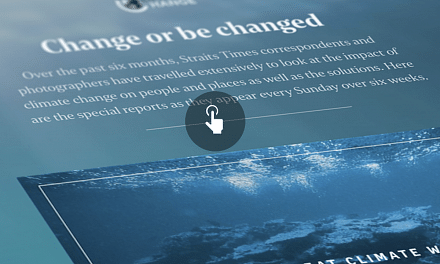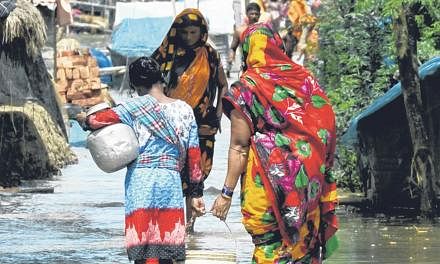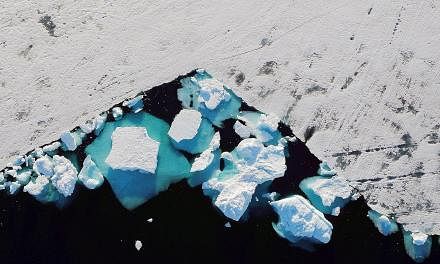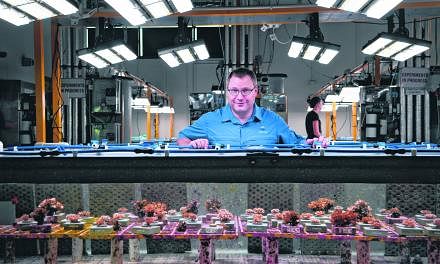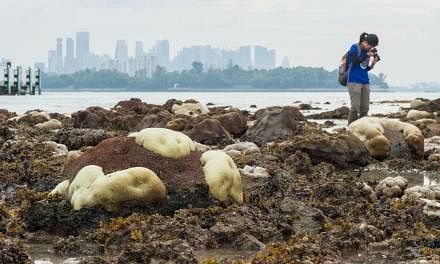BUHERA, ZIMBABWE (AFP) - Just under a year ago, Ms Alice Posha fled her home in the middle of the night and then watched as it was swept away by floods.
The torrential rain came from Cyclone Idai, one of the worst storms to hit Africa and the fiercest on record to strike Buhera, a district in the usually arid province of Manicaland in eastern Zimbabwe.
Today, the scene in Buhera is entirely different. But the misery remains.
The 60-year-old, who was rehoused in October, is going through the motions of weeding a field of maize that has been withered by the worst drought in 35 years.
A little rain for her corn would be more than welcome.
"Seeing how the maize is wilting, we may have a very bad harvest," she said.
It is a scene that is being played out across southern Africa, where chronic lack of rain is threatening mass hunger and ruin.
Climate is being fingered as the big culprit.
In the space of 10 months, Buhera and many districts like it have been hammered by extremes that scientists say are consistent with forecasts about climate change.
Last March, the arrival of Idai unleashed devastation on eastern Zimbabwe and its neighbours Mozambique and Malawi.
More than a thousand people died and the lives of millions of others were badly affected.

"Our chickens and turkeys were swept away," said Ms Posha's sister-in-law, Ms Josephine Ganye, who now depends on food aid.
She is among the 45 million people in southern Africa that the United Nations has said are threatened by famine.
Its World Food Programme (WFP) sent out a stark warning last month.
"This hunger crisis is on a scale we've not seen before and the evidence shows it's going to get worse," said Ms Lola Castro, WFP's regional director in southern Africa.
For the past five years, the entire southern tip of the African continent, where average temperatures are rising twice as fast as the global mean, has suffered from a significant lack of rain.
Every farmer, big or small, has been affected as well as breeders, hoteliers and teachers.
Prayers for rain
In Zimbabwe, the drought has added to a long list of crises, from stratospheric inflation to shortages of cash, petrol, medicines, water and electricity.
For many, daily life has become a nightmare.
"Almost everybody in my area is food insecure," said 68-year-old Mr Janson Neshava, who is a headman, or senior leader, in Buhera.

"We still do the traditional rain ceremonies, but to no avail. Even the wetlands are now dry and streams that used to flow throughout the year are all dry."
The WFP says that 60 per cent of Zimbabwe's 15 million people are food insecure.
According to Ms Patience Dhinda, a local official, this figure hits 80 per cent in Buhera, where the grain depot, which should house the state food aid, stands empty.
A year ago, the crops in Buhera had already suffered from drought before being washed away by Idai. This year, they risk being burned to a crisp by the relentless sun.
One meal a day
Around 800km further west, across the border in Zambia, first impressions suggest that the contrast is startling.
The grass is tall, the roads muddy and the fields of maize are a vibrant, healthy green.
In the village of Simumbwe, an hour and a half's drive south on a dusty road from Kalomo in the south-west of the country, the rains arrived in late December.

But in the shade of the majestic trees, seated on the red earth, perched in the branches or on oxcarts, hundreds of people wait patiently for food to be distributed by an non-government organisation, World Vision, and the WFP.
Last year, the harvest was catastrophic for the second year running with up to 70 per cent of the crops lost to the drought.
"Last year, I harvested 18 kilos of food. In other words, nothing," said Ms Loveness Haneumba, mother of five and a "happy" beneficiary of aid in Simumbwe.
"It is common that we eat once a day. The children ask me: 'What are we going to eat?' I answer: 'Just wait. Let me look around.'"
It is a question of buying time.
For several years, the rainy season has been getting later and shorter, upsetting the traditional farming cycle. It used to be from October to May; now it is barely from December to April.
Most vulnerable
"The food we have here is not enough to cater for everyone," said Mr Derick Mulilo, the World Vision food monitor in the yard of the school in Simumbwe. "We are focusing on the most vulnerable."
He meant people like Ms Haneumba and her stunted children. Her six-year-old daughter looks four and her four-year-old has the appearance of a two-year-old toddler.
Ms Lizzy Kayoba, another mother of a large family, also featured on the list of beneficiaries. She had walked five hours during the night, her youngest on her back, to arrive at dawn for the food handout.
She left with 25kg of maize and 7.6kg of beans.
"It will last me one or two weeks," she said.
The next distribution at the school is a month away.

A teacher, Mr Teddy Siafweba, said about 15 children in his class were absent that day because of hunger. In the classroom next door, about 30 were missing - nearly half of the roll call of 70.
And those who came often have an empty stomach. Some nod off in class, said another teacher, Ms Tryness Kayuni.
The 33-year-old watched the handout with a heavy heart. She was not one of the 862 beneficiaries.
A single mother, Ms Kayuni was not considered a priority as she had a job.
And yet she had not been paid since September.
Since then she had been holding out on one meal a day.
"How do I survive?" she said. "I ask my colleagues if they can help me with some food."
Adapt to survive
Funding is desperately needed to meet the needs of the 2.3 million people in Zambia who sorely need food. The WFP has received only a third of the US$36 million (S$50 million) required.
Desperate times are prompting desperate - and corrupt - measures.
Thieves steal food supplies and unscrupulous men promise to put women's names on the food list in exchange for unprotected sex.
That is not something that worried single mother Imelda Hicoombolwa, 49, who for the last three years has been one of a number of small farmers who gambled on agricultural diversification, opting for nutritious vegetables and using techniques adapted to climate change.
"Food is not a problem. I have it," she beamed.

Before 2017, Ms Hicoombolwa cultivated almost only maize. Today, she harvests cowpeas, which need very little water, as well as peanuts, pumpkins and sunflowers.
"I can make 18,000 kwacha (S$1,700) a year. Before, I was making 8,000 kwacha a year," she said.
"Before, the children were missing school because I could not always pay the tuition fees. Not any more."
One big change is that Ms Hicoombolwa no longer rushes to sow from the first rains. The farmers have learnt to wait.
In the recent past, it was a different story, according to Mr Allan Mulando of WFP.
"Once they see a drop, they plant instead of waiting for the moisture to be good enough," he said. "At the end of the day, they lose everything."
Rain gauges have helped to change that attitude.
As part of a joint programme launched in 2015 by the UN agency and the Zambian government, 165 rain gauges were distributed to farmers in the Zambian districts most affected by the drought.
They have enabled the villagers to read the conditions and plant at the most propitious moment.
Rain man
Mr Mulando says the rule of thumb is not to plant anything below 20ml to 25ml of rain and to choose seeds that fit the weather forecast.
If a short rainy season is expected, for instance, choose seeds that will germinate quickly.
"If I had had access to this knowledge earlier, I would be relatively rich," said Mr Godfrey Hapaka, a farmer.
"I would have a decent car and my kids would not have missed school."
Next to his modest house surrounded by flourishing maize fields, a rain gauge was planted in an enclosure, its value underlined by a brand new screen put in place to protect it.

As soon as it rains, Mr Hapaka, 58, checks the gauge and passes on the rainfall level to his neighbours.
Sadly, the message is often ignored.
Mr Hapaka said some of them are "reluctant" to use the information.
"They follow their parents and grandparents," he said. "They are stuck in the past."
Farmers are not the only ones to follow the rainfall closely.
From the Kariba dam on the border between Zambia and Zimbabwe, Mr Geoffrey Chambisha, director of the power station on the Zambian side, watched the water level of the lake. He was worried.
In the 14 years he had been working at the dam, he had never seen it so low.
In early 2020, the water level was 476.61m above sea level. Its lowest level, set in 1996, was 475.93m.
In the absence of sufficient rain, the dam, the main source of electricity in Zambia and Zimbabwe, is expected to operate at only 25 per cent of its capacity in 2020.
Inevitably the two countries are enduring long power cuts, up to 20 hours a day, which is having a knock-on effect on the two economies.
The town of Livingstone, where tourists from all over the world flock to admire the Victoria Falls, has been particularly hit.
"This year has been horrendously bad," said Mr Andrew Murrin, a Briton who runs a six-bedroom hotel.
With temperatures climbing to nearly 45 deg C, customers have naturally been demanding air-conditioning.
Mr Murrin had been running at full speed on his generator for some months and the cost was mounting.
"In the past three months, the generator has cost me about 30,000 kwacha for the diesel and the maintenance," he said.
Victoria Falls
Beyond the problems of electricity and air-conditioning, the tourist industry is suffering from recent publicity which it would rather have avoided.
A video filmed in September by a visitor purporting to show the Victoria Falls reduced to a trickle made a massive buzz on social media even though it only reflected part of the reality.
The video showed a dry portion of the 1.7km-long falls and, much to the indignation of angry tourism professionals, ignored the rest of the free-flowing Mosi-oa-Tunya - the local name which translates as "The Smoke That Thunders".
Zambian President Edgar Lungu exacerbated the panic by leaping for Twitter.
"These pictures of the Victoria Falls are a stark reminder of what climate change is doing to our environment and our livelihood," he tweeted.
At Livingstone, the locals were incensed.
Every year, the Zambian part of the Victoria Falls, which is shared with Zimbabwe, is dry.
"It is a natural phenomenon; it is seasonal," said Mr John Zulu, who runs the Zambian site.
Too late. The damage was done. Thousands of visitors cancelled their trips; tourism plummeted 25 per cent in 2019.
This month, the falls are again flowing along their entire length, but the lack of tourists has bitten hard.
Mr Murrin has had to lay off four of his eight employees and the hotel next door to him has closed down.
Stench of death
Tourists have also become a rarity 1,500km away in western South Africa.
In the Northern Cape province, at the gateway of the Kalahari desert, the wild animals are used to extreme temperatures, but even they are succumbing to the conditions.
According to Wildlife Ranching South Africa, two-thirds of the wild animals in the Northern Cape have died in the last three years because of the drought.
In two years, half of the 4,500 buffaloes, hippopotamuses and kudus at the Thuru Lodge game farm near Groblershoop have disappeared.
The average rainfall here is 250ml a year.
"But 250ml, that's what we have had in five years," says its manager, Mr Burger Schoeman.
At the top of a hill that overlooked the 22,000ha private reserve, two huge holes served as mass graves.
Mr Paul Ludick is usually responsible for locating animal tracks for tourists. He now spends his time picking up the carcasses and feeding the animals that are still alive but struggling to survive.
"I stink" of death, he said.
Abandoned sheep
The drought represents a financial black hole for the lodge, which spends 200,000 rand (S$18,700) per month to feed the animals while cancelling the reservations of tourists on the lookout for "trophies".
"We need to offer a fair hunt. Hunters can't shoot weak animals," said Mr Schoeman.
The South African government, which has declared a state of natural disaster in the Northern Cape, will release 300 million rand in aid. A drop in the desert.
"I have never seen anything like this," said Mr Johan Steenkamp, a 52-year-old farmer with a spread of 6,000ha.
"It is just not raining anywhere. We lost many animals. I have 30 to 40 per cent left."
More than 100 died because of the drought, with another 200 going prematurely to the slaughterhouse.
It is becoming a familiar tale. According to the agricultural cooperative KLK, many farmers in the region have lost between 30 and 70 per cent of their livestock in the space of two years.
Sheep still give birth, but they abandon their newborn lambs.
"They have no milk," Mr Steenkamp said. "They leave them there."
Mr Steenkamp's two older sons chose careers away from the family farm and the drought is painting a bleak future for his youngest son as well.
"There is no future for him here," said Mr Steenkamp.

